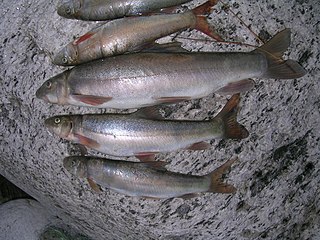
Acrossocheilus is a genus of ray-finned fishes in the family Cyprinidae, native to freshwater in China, Taiwan, Laos, and Vietnam. They are fairly small, no more than 30 cm (1 ft) in standard length.

Romance of the Three Kingdoms is a Chinese television series adapted from the classical 14th century novel of the same title by Luo Guanzhong. The series was produced by China Central Television (CCTV) and was first aired on the network in 1994. It spanned a total of 84 episodes, each approximately 45 minutes long. One of the most expensive television series produced at the time, the project was completed over four years and involved over 400,000 cast and crew members, including divisions of the People's Liberation Army from the Beijing, Nanjing and Chengdu military regions. Some of the dialogues spoken by characters were adapted directly from the novel. Extensive battle scenes, such as the battles of Guandu, Red Cliffs and Xiaoting, were also live-acted.

Schizothorax is a genus of cyprinid fish found in southern and western China, through northern South Asia (Himalaya) and Central Asia, to Iran, with a single species, S. prophylax, in Turkey. They are primarily found in highland rivers, streams and lakes, although a few species occur in lower-lying locations, like Lake Balkhash and lakes of the Sistan Basin. Their scientific name means "cloven-breast", from Ancient Greek schízeïn (σχίζειν) "to cleave" and thórax (θώραξ) "breast-plate". The western species are typically referred to as marinkas from their Russian name marinka (маринка), while the eastern species are usually called snowtrout. Although they do resemble trouts in habitus this is merely due to convergent evolution and they are by no means closely related apart from both being Teleostei: Cyprinids are in the teleost superorder Ostariophysi, while trouts are in the superorder Protacanthopterygii. Their ancestors must thus have diverged as early as the Triassic, more than 200 million years ago.
Sinocyclocheilus is a genus of freshwater fish in the family Cyprinidae endemic to China, where only found in Guangxi, Guizhou and Yunnan. Almost all of its species live in or around caves and most of these have adaptions typical of cavefish such as a lack of scales, lack of pigmentation and reduced eyes. Several species have an unusual hunchbacked appearance and some of the cave-dwellers have a "horn" on the back, the function of which is unclear. In contrast, the Sinocyclocheilus species that live aboveground, as well as a few found underground, show no clear cavefish adaptions. They are relatively small fish reaching up to 23 cm (9.1 in) in length. The individual species have small ranges and populations, leading to the status of most of the evaluated species as threatened. Many species populations in the genus have yet to be evaluated by the IUCN.

Gobio is a genus of typical gudgeons, ray-finned fish in the family Cyprinidae many of which are endemics of south-eastern Europe. Members of the genus are usually small fish, rarely longer than 10 cm.

Oreonectes is a genus of fish in the family Nemacheilidae found in the rivers and cave of Asia. Many of these species are troglobitic.

Triplophysa is a genus of fish in the family Nemacheilidae found mainly in and around the Qinghai-Tibet Plateau in China. Currently, the genus is a mixed assemblage of species. Some lineages have been identified and treated as subgenera, but as Wikipedia follows Fishbase for fish species these have been treated as subgenera in Wikipedia, although Kottelat and the Catalog of Fishes treat them as genera. FishBase, however, includes these in Triplophysa without specifying subgenera and treats the names given by Kottelat as synonyms.

Three Kingdoms is a 2010 Chinese television series based on the events in the late Eastern Han dynasty and the Three Kingdoms period. The plot is adapted from the 14th century historical novel Romance of the Three Kingdoms and other stories about the Three Kingdoms period. Directed by Gao Xixi, the series had a budget of over 160 million RMB and took five years of pre-production work. Shooting of the series commenced in October 2008, and it was released in China in May 2010.

Aphyocypris is a genus of cyprinid fishes consisting of eight species, all of which are restricted to East Asia.
Huigobio chenhsienensis is a species of cyprinid fish found only in the Cao'ejiang and Zhujiang Rivers in China. This species can reach a length of 8.3 centimetres (3.3 in) SL. It is of minor importance to local commercial fisheries.
Saurogobio is a genus of cyprinid fish found in eastern Asia.

The Patriot Yue Fei is a 2013 Chinese television series based on the life of Yue Fei, a Song dynasty general widely regarded as a patriot and national hero in Chinese culture for his role in the Jurchen campaigns against the Song dynasty. While the plot is based on historical sources, it also includes elements of fiction and draws ideas from the novel General Yue Fei (說岳全傳) and other folktales on the general's life.

Tang Ming Huang is a Chinese television series based on historical events in the reign of Emperor Xuanzong of the Tang dynasty. The series was directed by Chen Jialin and starred Liu Wei as the eponymous emperor. It was first broadcast on CCTV-1 in 1990 in mainland China.

Zhuge Liang is a Chinese television series based on the life of Zhuge Liang, a chancellor of the state of Shu Han in the Three Kingdoms period. The plot is based on stories about Zhuge Liang in the 14th-century historical novel Romance of the Three Kingdoms. The series starred Li Fazeng as the title character and was first aired on Hubei TV in mainland China in 1985.

Gobioninae is a monophyletic subfamily of Eurasian cyprinid fishes. A species-rich subfamily, it is divided into five tribes: Gobionini, Pseudogobionini, Hemibarbini, Coreiini, and Sarcocheilichthyini.

The Heart of Woman, also known as Women, is a Taiwanese Hokkien television series that began airing on SET Taiwan in Taiwan on 21 November 2012, from Mondays to Fridays, and ends on 21 November 2013, lasting one year with a total of 262 episodes.
Troglonectes is a genus of troglobitic fish in the family Nemacheilidae, native to caves of Asia. Fishbase and other authorities place these species in the genus Oreonectes.













